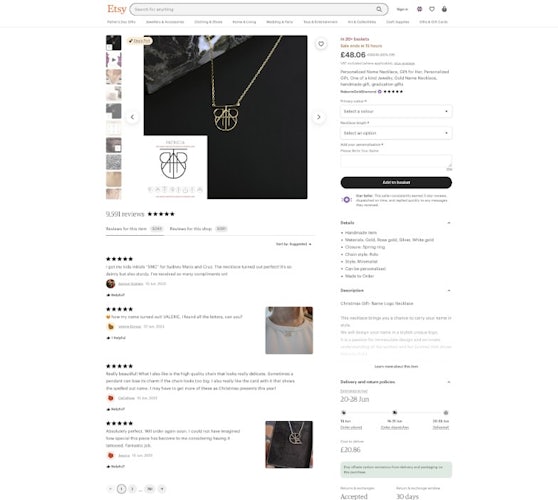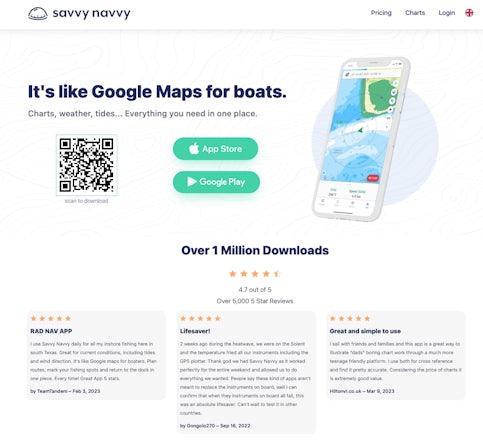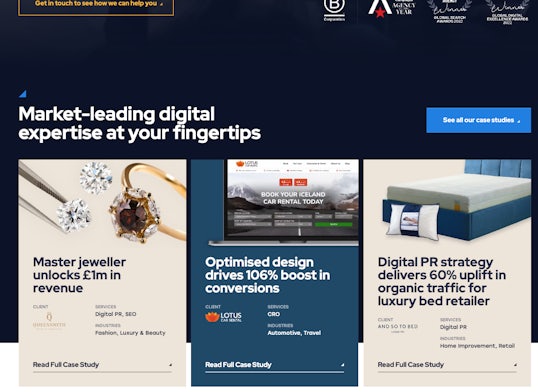To harness the power of customer trust, we must understand the phenomenon of social proof; the principle where individuals rely on the actions of others as an indicator of what is socially acceptable, correct or desirable.
- What is social proof?
- The benefits of social proof
- What content types can you use to leverage social proof?
- Examples of social proof in practice
- Customer reviews - Etsy
- Testimonials - Savvy Navvy
- Certifications & customer base - Monzo?
- Client base - Canva
- User-generated content - Oliver Bonas
- Case studies - Impression Digital
- Key things to consider with social proofing
What is social proof?
Social proof, in the context of conversion rate optimisation, refers to content that showcases evidence of how other individuals have purchased a product or service and found value in it.
This powerful phenomenon, also known as ‘the bandwagon effect’, influences people to be more inclined to purchase a product when they observe others engaging in the same behaviour.
We can use different content types to communicate social proofing on our websites, improving user trust, brand credibility, conversion rate and revenue.
The benefits of social proof
- It builds credibility and authority – Showcasing industry certifications, awards and accreditations is a great way to build credibility and establish yourself as a key market player in customers’ minds.
- It helps users to overcome scepticism – If a user is unfamiliar with a brand, they can be sceptical at the first touchpoint. It takes time and influence to build trust and awareness, after all. By utilising social proof, you can effectively alleviate some of the perceived risks for users and improve confidence in your brand.
- It helps establish yourself as a unique and legitimate market player, differentiating you from competitors – Tangible data and statistics will help solidify your status as a major player or market leader. In a competitive marketplace, capturing customer attention is a challenge, and social proof can help to cut through the noise.
- It enhances the user experience – Page design that strategically integrates social proof content with your own enriches the overall user experience. By thoughtfully incorporating credible social proof, your content gains an added layer of credibility and persuasiveness.
- It helps you to build long-term relationships with customers – Social proof is a great way to engage with customers, build trust and generate content. By incorporating social proof into your digital marketing strategy, you can cultivate a sense of community, strengthen customer relationships and build loyalty.
What content types can you use to leverage social proof?
- Customer reviews
- Testimonials
- Awards, accreditations and certifications
- Case studies
- Existing customer base numbers
- User-generated content (UGC)
Examples of social proof in practice
Customer reviews – Etsy
For sellers of handmade, vintage and unique items, Etsy fully utilises customer reviews by placing them directly below the images on their product landing pages, giving them more presence than the product description.

Why does it work?
The ‘centre-stage’ placement of review content both establishes trust for the user and helps them reduce the risk of buying from a new seller.
Etsy also shows reviews for the seller, which further enhances trust in the product. This two-fold approach is helpful if the product doesn’t have many reviews; if the seller reviews are positive, the user can have confidence the product is likely to be good value for money.
Etsy also allows users to upload images against reviews. According to BazaarVoice, shoppers are 62% more likely to purchase if they can view customer videos and photos in reviews.
Testimonials – Savvy Navvy
Nautical navigation app Savvy Navvy uses powerful testimonials taken from customer reviews and places them directly below their download button.

Why does it work?
The placement of these testimonials is notable. It’s above their own claims and features content, meaning they let their users speak for them, giving power to the customer.
The additional impact is created by including the date from each testimonial’s post. Recency is an important part of social proof content. For example, if the content is from 3 years prior, it becomes less relevant and credible.
Certifications & customer base – Monzo
Online bank Monzo uses multiple social proofing elements on their homepage to drive impact.

Why does it work?
Monzo features their certifications, Trustpilot ratings and their customer database directly below the hero area. Their clear CTAs also allow users to sign up quickly after seeing these authority prompts.
It’s also worth noting their Trustpilot star rating is 4.3 out of 5 based on 26,775 reviews. A rating between 2.7 and 4.7 is considered the most believable and trustworthy. A 5.0-star rating can seem ‘too good to be true’, resulting in reduced trust in your product or service.
Client base – Canva
Design software Canva features some of the well-known brands they work with using a black and white logo carousel.

Why does it work?
While these logos don’t refer to an individual experience, they intend to convey confidence towards Canva’s potential clients by showcasing their credibility and history.
Featuring the logos in black and white also helps them stay relevant and visible without distracting from Canva’s messaging and branding on their homepage. Canva also confidently calls out that they are ‘trusted by well-known companies’, reinforcing their reputation.
User-generated content – Oliver Bonas
Homeware, gift and fashion retailer Oliver Bonas features its customers’ social media content on its homepage. They link directly to the products featured in the content allowing customers to shop what they see.

Why does it work?
According to BazaarVoice, Oliver Bonas saw a 26% increase in average order value when this type of social content was shown on their website.
This is an authentic way of marketing products, and using content that users are more likely to respond to. Interacting with customers this way is also beneficial in building loyalty and customer lifetime value.
Case studies – Impression Digital
At Impression, we feature case studies directly below the hero area of our website.

Why does it work?
Case studies help potential clients see examples of some of the great work done and act as a trust signal that backs up our headline message ‘digital growth specialists’. No one likes a brag, but we think we do a pretty good job with how our case studies are presented, see more examples here.
To ensure the case studies are credible, numbers are used in the headline of each case study.
Key things to consider with social proofing
As we’ve seen, there are so many ways to leverage social proof, and it may be tempting to plaster all the content you have on your homepage. Woah there! The best way to understand what will really drive an improved conversion rate is to experiment.
A/B or multivariate testing is the best way to gather data and decide which social proofing tools will work for your website, and how best to execute them from a design point of view.
The other key thing to bear in mind is not to overuse social proofing. If overly relied on, we risk users having ‘banner blindness’, and your message could come across as inauthentic.
Get in touch with our CRO team to see how we can help you drive real growth and unlock the most from your website via social proofing. For more CRO top tips, be sure to check out more CRO blogs on our site.





